4D Printing Statistics By Revenue, Market Size and Technological Advancement
Updated · Aug 23, 2024
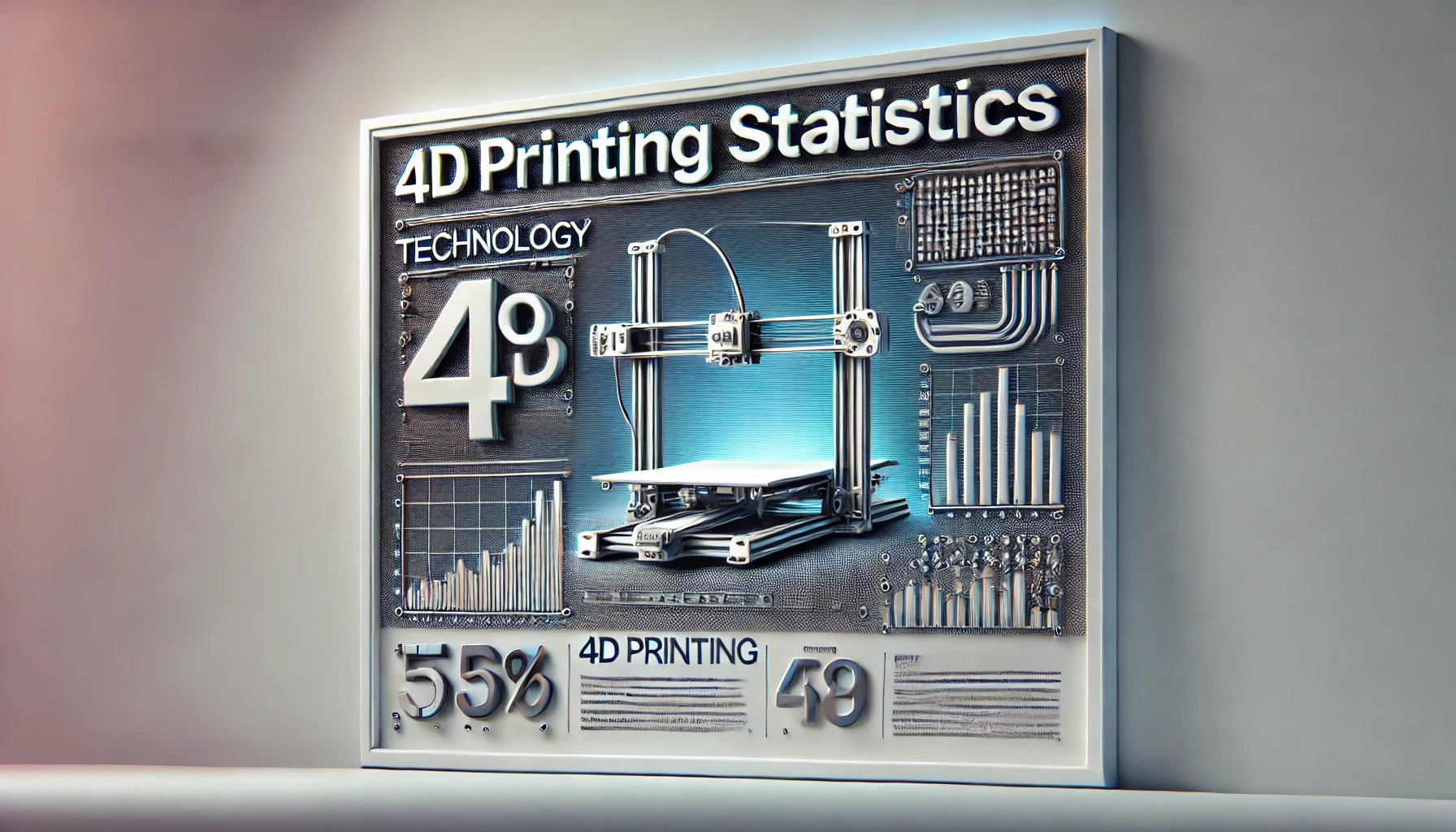
Table of Contents
Introduction
4D Printing Statistics: 4D printing is an advanced form of 3D printing that involves creating structures capable of transforming over time in response to environmental stimuli. The global 4D printing market is expected to reach around USD 13,948 million by 2033, up from USD 472 billion in 2023, with a projected compound annual growth rate (CAGR) of 40.3% during the forecast period from 2024 to 2033. Key drivers of this growth include technological advancements, industry adoption, and cost efficiency.
Applications of 4D printing extend to areas including healthcare (custom implants), aerospace and automotive (adaptive components), and construction (self-assembling materials). Despite its potential, challenges such as high material costs and design complexity persist. The statistics reflecting the growth of 4D printing underscore its transformative impact and underscore the importance of monitoring developments in this innovative field.
Editor’s Choice
- The 4D Printing Market is projected to reach USD 13,948 million by 2033, up from USD 472 million in 2023, with an annual growth rate of 40.3%.
- In 2023, the Programmable Carbon Fiber segment accounted for 34.6% of the market, signifying its significance in the 4D printing industry.
- The Aerospace and Defense sector emerged as the largest user of 4D printing in 2023, capturing a market share of 35.6%.
- In 2023, North America led the 4D printing market, holding 37.4% of the global market and generating revenue of USD 176.5 million.
- Programmable Carbon Fiber dominated the material usage in 2023, holding a market share of 34.6%.
- Leading 4D Printing key players are Stratasys Ltd., Materialise NV, Autodesk Inc., Hewlett Packard Enterprise Company, CT Core Technology Group, EnvisionTEC Inc, ExOne Corporation, Norsk Titanium US Inc., Materialise NV, Autodesk Inc, Hewlett Packard Enterprise Company, CT Core Technology Group, EnvisionTEC Inc., ExOne Corporation and Norsk Titanium US Inc

Technological Advancement
- Smart Materials: The development of smart materials such as shape-memory polymers and hydrogels has accelerated. By 2024, the smart materials market in 4D printing is expected to reach USD 500 million, representing a significant portion of the overall 4D printing market. 4D printing statistics show that these materials are critical for the future growth of the industry.
- Multi-Material Printing: Advances in multi-material 4D printing are enabling the creation of difficult projects and tasks with varied properties. According to recent 4D printing statistics, the market for multi-material 4D printing is projected to grow at a CAGR of 28% from 2020 to 2024.
- Software Innovations: New software tools for 4D printing design and simulation are enhancing the precision and efficiency of creating dynamic objects. According to the latest 4D printing statistics, investments in 4D printing software are expected to reach USD 150 million by 2024.
- Nanoscale 4D Printing: Research into nanoscale 4D printing is progressing, with potential applications in medicine and electronics. According to 4D printing statistics, the market for nanoscale 4D printing is estimated to be USD 200 million by 2024.
- Bio-Printing: Significant advancements in 4D bio-printing are anticipated to revolutionize regenerative medicine. As indicated by recent 4D printing statistics, the market for 4D bio-printing in medical applications is projected to grow to USD 250 million by 2024.
Impact on Industries
- Manufacturing: The use of 4D printing in manufacturing is expected to reduce production times and costs by 25%. Based on current 4D printing statistics, the market for 4D printing in manufacturing is projected to be USD 600 million by 2024.
- Construction: 4D printing technology is being explored for use in adaptive building materials. According to 4D printing statistics, the market for 4D printing in the construction industry is forecasted to grow to USD 200 million by 2024.
- Textiles: The textile industry is incorporating 4D printing to create smart fabrics. According to the latest 4D printing statistics, the market for 4D-printed textiles is expected to be worth USD 100 million by 2024.
4D Printing Market Forecast
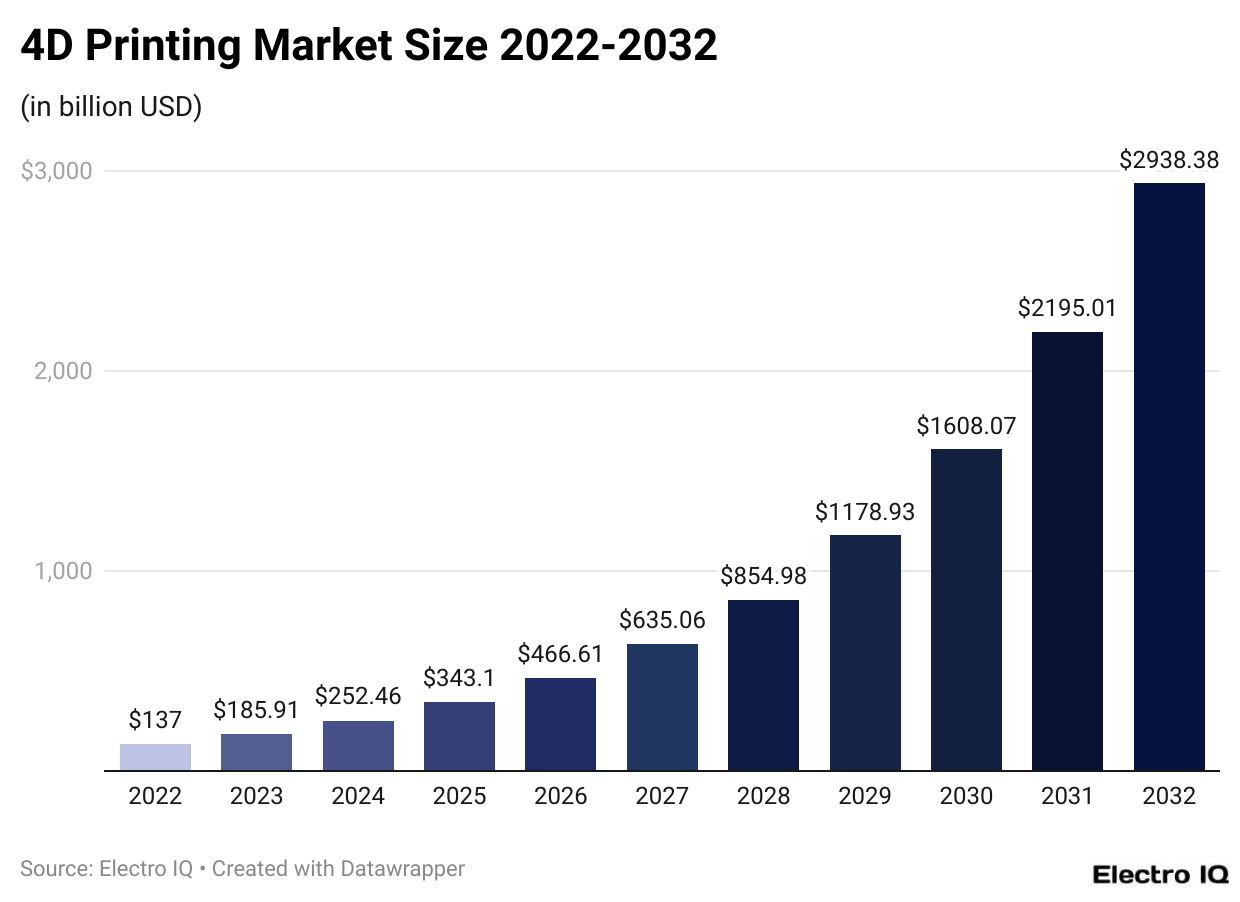
(Source: precedenceresearch.com)
North America
- Market Size: The North American 4D printing market is projected to reach USD 720 million by 2024.
- Growth Rate: The region is expected to experience (CAGR) of 28.7% from 2020 to 2024.
- Key Drivers: Strong investments in research and development, advanced technological infrastructure, and early adoption across industries such as healthcare and aerospace are key drivers.
- Top Countries: The United States and Canada are the leading countries in the North American 4D printing market.
Europe
- Market Size: The European 4D printing market is expected to grow to USD 540 million by 2024.
- Growth Rate: Europe is projected to have a CAGR of 28% from 2020 to 2024.
- Key Drivers include government support for innovation, a strong manufacturing base, and significant investments in smart materials and sustainable technologies.
- Top Countries: Germany, the United Kingdom, and France are leading the way in 4D printing advancements in Europe.
Asia-Pacific
- Market Size: The Asia-Pacific 4D printing market is estimated to reach USD 400 million by 2024.
- Growth Rate: This region is expected to grow at the fastest rate, with a CAGR of 35% from 2020 to 2024.
- Key Drivers include rapid industrialization, growing investments in advanced manufacturing technologies, and increasing adoption in sectors like automotive and electronics.
- Top Countries: China, Japan, and South Korea are the primary contributors to the growth of the 4D printing market in Asia-Pacific.
Latin America
- Market Size: The Latin American 4D printing market is projected to be USD 100 million by 2024.
- Growth Rate: The region is expected to see a CAGR of 25% from 2020 to 2024.
- Key Drivers: Emerging markets with increasing investments in technology and innovation, particularly in the healthcare and manufacturing sectors.
- Top Countries: Brazil and Mexico are leading the region in adopting 4D printing technologies.
Middle East and Africa
- Market Size: The Middle East and Africa 4D printing market is forecasted to reach USD 40 million by 2024.
- Growth Rate: The region is expected to experience a CAGR of 20% from 2020 to 2024.
- Key Drivers: Growing interest in advanced technologies and innovation, coupled with investments in sectors such as construction and healthcare.
- Top Countries: The United Arab Emirates and South Africa are leading the way in the adoption of 4D printing in the Middle East and Africa.
Emergence of 4D Printing from 3D Printing
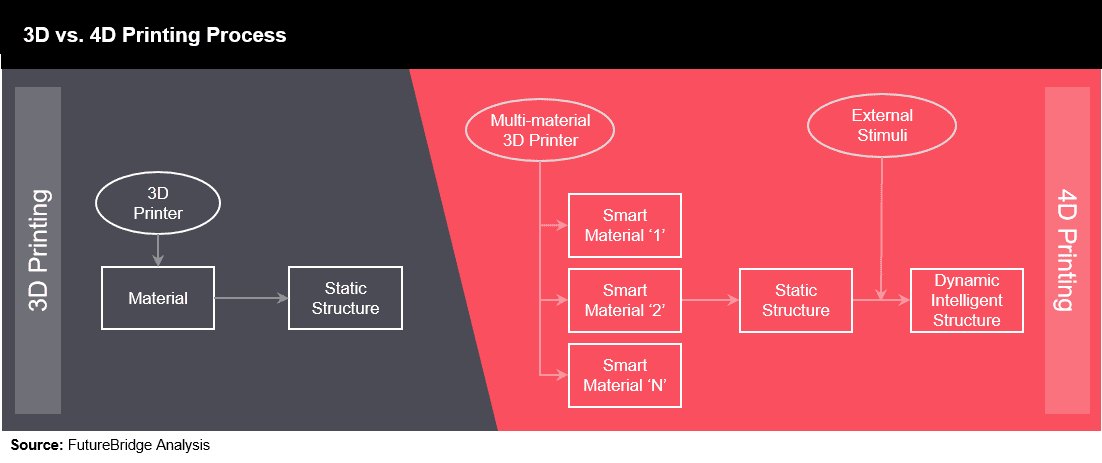
- 3D printing is a groundbreaking method in modern manufacturing. It has revolutionized the production, design, and development of parts and equipment.
- 3D printing allows the creation of complex shapes that were previously impossible with traditional manufacturing techniques.
- Over the last 30 years, 3D printing technology has seen significant advancements and changes.
- Even though 3D printing can produce intricate, multi-material designs, it is not yet suitable for large-scale production.
- The need for flexible objects in various fields, like self-folding packaging and adaptive wind turbines, has driven the rise of 4D printing.
- Researchers are moving beyond 3D printing to create meta-material structures. These structures combine different materials to react in specific ways when triggered by external factors.
- By printing with various materials, 4D printing can produce objects that change shape by bending, twisting, elongating, or corrugating along their axes.
- Researchers aim to apply these shape-changing abilities to create items like lockers, lifters, microtubes, soft robots, and toys.
- 4D printing refers to the ability of objects to alter their shape over time, using the properties of different materials.
- The key differences between 3D printing and 4D printing lie in the materials used and the printing process itself.
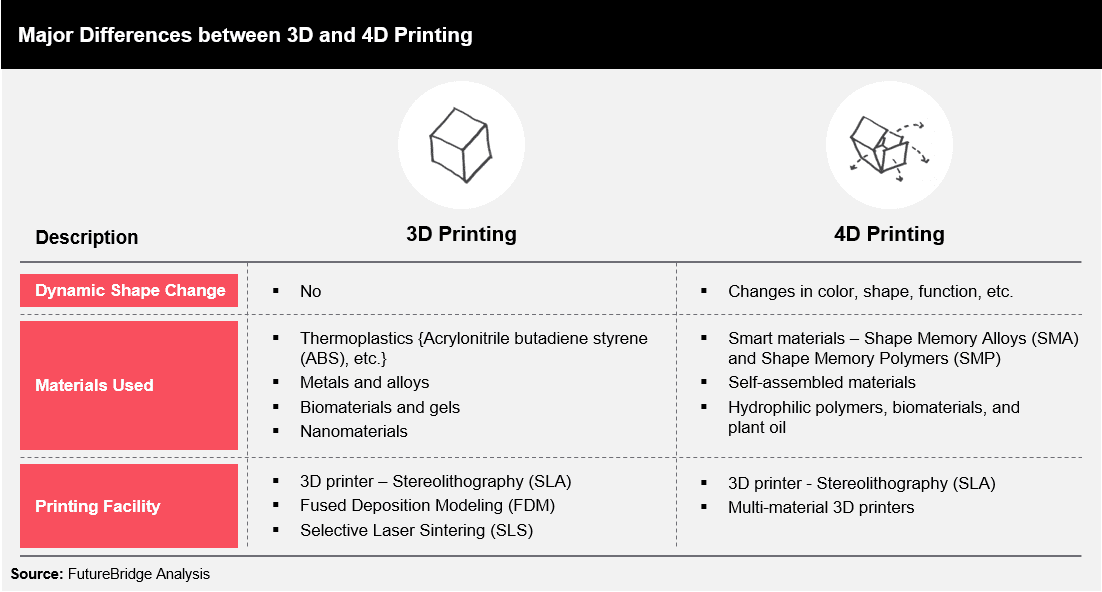
Applications of 4D Printing
Current Product Research in 4D Printing
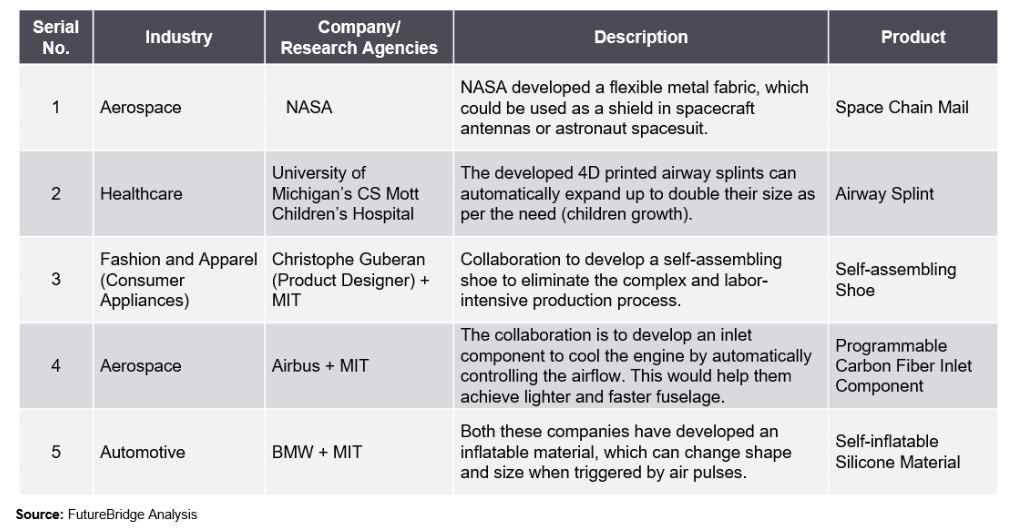
- BMW and MIT developed a self-inflating silicone material. This material inflates with air pulses. Experts believe it could revolutionize pneumatics.
- Many key players in the 4D printing industry are involved in research and development.
- In healthcare, 4D printing is being used for targeted drug delivery. It is also helping to create stents that require minimal surgical invasion. Shape-changing splints are another application in this field.
- The development of soft robotics is advancing with 4D printing technology.
- Hydraulic and pneumatic actuators are also benefiting from 4D printing innovations.
- In construction, 4D printing could lead to the creation of self-healing roads and bridges.
Possible Impact Timeline of 4D Printing on Various Applications Across Industries
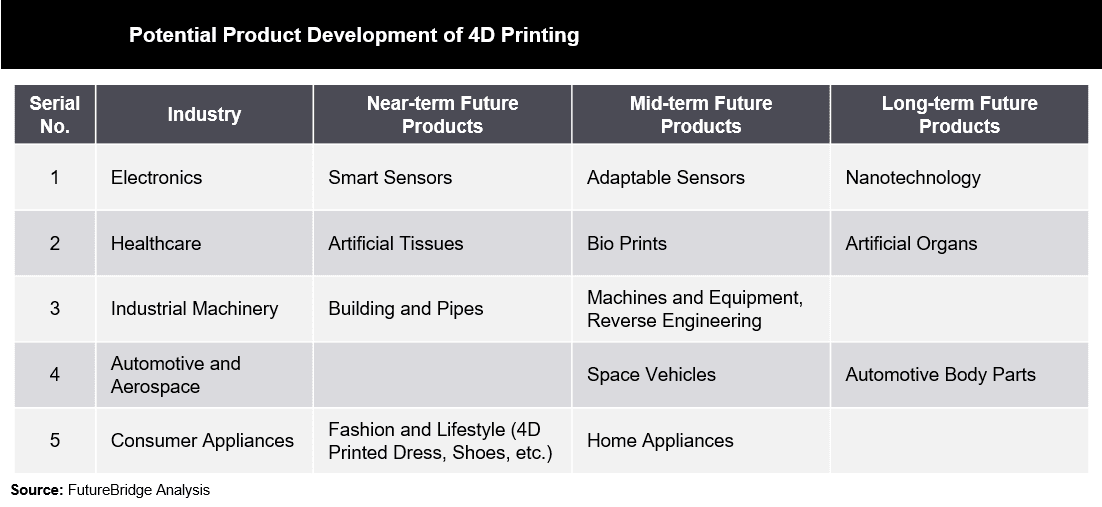
Technology Maturity of 4D Printing
The image below shows the current stage of 4D printing technology development. 4D printing is currently in the “innovation trigger” phase, which means it’s generating a lot of excitement, but it will likely take over 10 years before it becomes widely used and reaches its full potential. The same hype cycle also shows that many advancements in 3D printing are still in the early stages, meaning 3D printing has a long way to go.
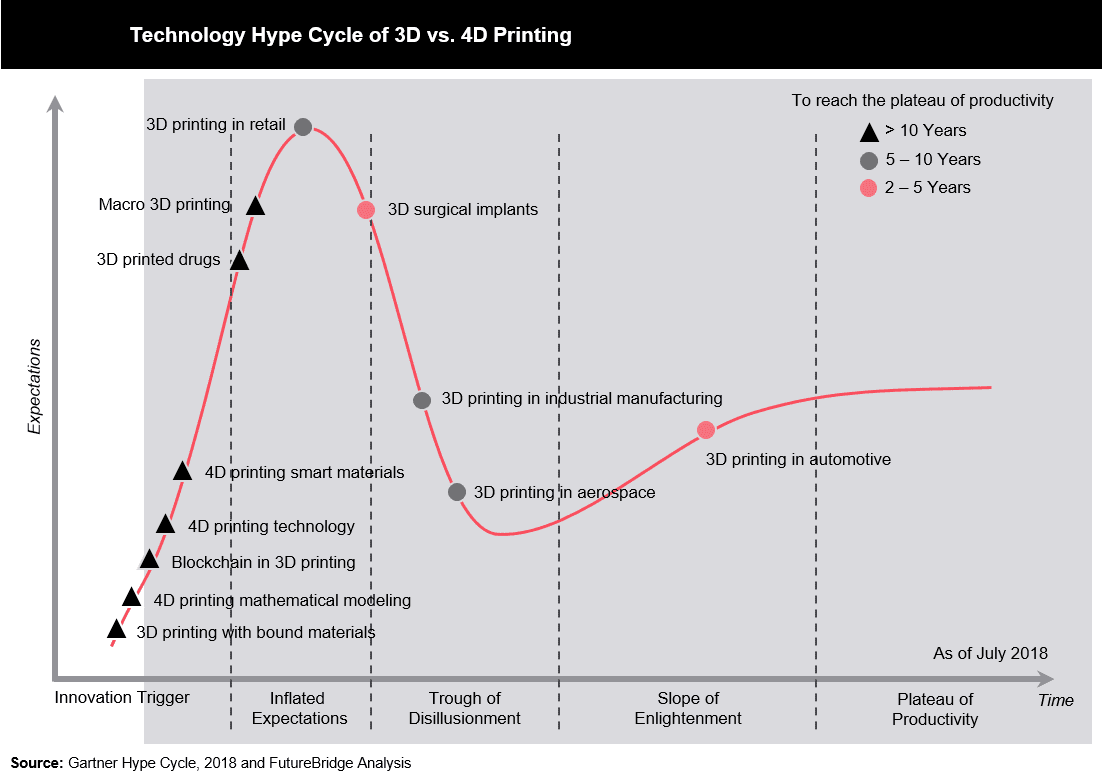
Since 4D printing builds on 3D printing, its progress might be slow. However, 4D printing doesn’t always have to follow the path of 3D printing. While 3D printers’ abilities to print multiple materials and on different axes are important, advancements in 4D printing also depend on research in smart materials and mathematical modeling, which aren’t entirely tied to 3D printing.
Conclusion
Several industries, including healthcare, electronics, automotive, aerospace and defense, consumer appliances, textiles, construction, and industrial machinery, are actively exploring 4D printing through various research and development projects. Although 4D printing is still a new technology, it offers significant potential, which many experts recognize.
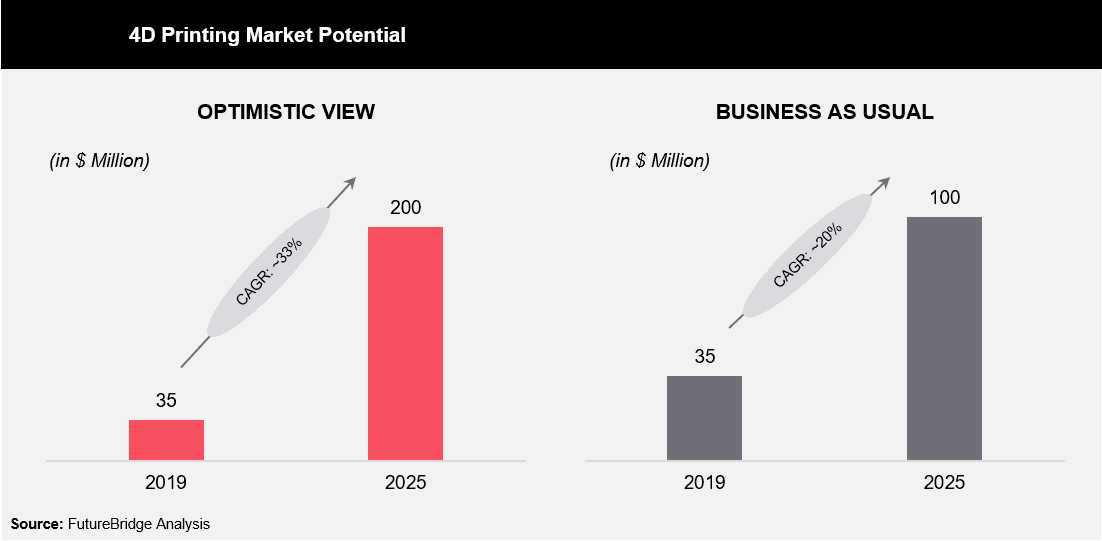
The market for 4D printing is gradually taking shape, driven by ongoing R&D efforts. Opinions on its growth vary. Optimistic projections suggest that the market could expand at a compound annual growth rate (CAGR) of around 33%, increasing from $35 million in 2019 to $200 million by 2025. However, given its early-stage development, some predict a more modest growth rate of about 20% by 2025.
Despite its promise, 4D printing faces several technical challenges before it can be widely adopted. Key obstacles include the inability to support complex structures, the lack of multi-material and affordable printers, slow printing speeds, and concerns about the long-term reliability of printed objects. While advancements like 5-axis printing equipment are helping to address some issues, such as the need for support structures, other challenges remain.
Additional difficulties, such as slow and imprecise actuation, limited control over deformation states, and a lack of available materials, also contribute to the slow adoption of 4D printing. However, the strong interest from manufacturers and the intensity of research suggest that the technology could advance more rapidly than anticipated. Companies aiming to stay ahead in technological innovation should closely follow developments in 4D printing and consider its potential impact on their industries.
FAQ.
4D printing is a technologically advanced form of 3D printing that helps modify the dimensions of time. It allows printed objects to change shape or function when exposed to external stimulating factors such as heat, light, or moisture. This transformation is achieved using smart materials that react to these environmental factors.
The global market for 4D printing is projected to reach $1,800 million by 2024, growing at a 31% annual growth rate (CAGR) from 2020 to 2024.
Key drivers include:
- Technological advancements in smart materials.
- Increased investment in research and development.
- The ability to create dynamic, adaptive products that improve efficiency and reduce costs.
The most impacted industries include:
- Healthcare: Expected cost savings of $400 million by 2024 due to advancements in medical devices.
- Aerospace: Projected savings of $250 million from lightweight and adaptive components.
- Automotive: Anticipated savings of $300 million through innovative materials and designs.
- Construction: Market value of $200 million for adaptive building materials by 2024.
Significant advancements include:
- Smart Materials: Shape-memory polymers and hydrogels.
- Multi-Material Printing: Creating complex structures with varied properties.
- Nanoscale 4D Printing: Applications in medicine and electronics.
- Bio-Printing: Innovations in regenerative medicine.
- North America: Expected to invest $500 million by 2024.
- Europe: Projected market size of $540 million by 2024.
- Asia-Pacific: Fastest growth with a market size of $400 million by 2024.
Economic benefits include:
- Significant reduction in manufacturing costs (up to 25%).
- Enhanced product customisation and personalisation.
- Reduction in material waste by 30%.
- Industry-specific cost savings (healthcare, aerospace, automotive).
Challenges include:
- High costs of smart materials.
- Technical complexities in the design process.
- Need for standardization and regulatory frameworks.
The future of 4D printing is promising, with expected advancements in technology, increased adoption across industries, and significant economic benefits. The market for personalized 4D-printed products is projected to be worth $350 million by 2024, and ongoing R&D investments are expected to reach $200 million globally by 2024.
4D printing contributes to sustainability by reducing material waste by 30% and enabling the creation of sustainable products.

Joseph D'Souza founded ElectroIQ in 2010 as a personal project to share his insights and experiences with tech gadgets. Over time, it has grown into a well-regarded tech blog, known for its in-depth technology trends, smartphone reviews and app-related statistics.










